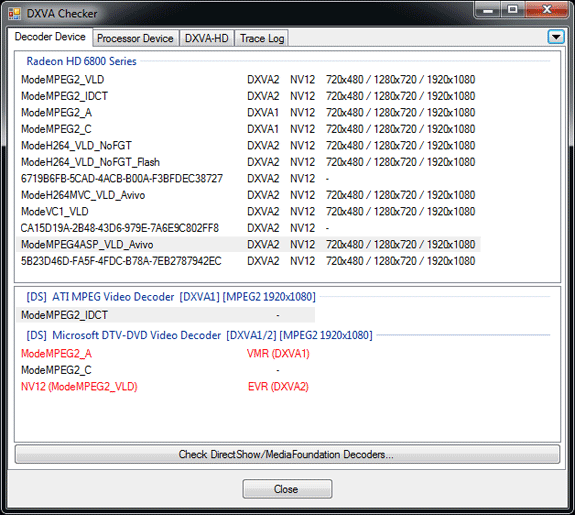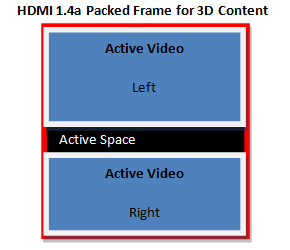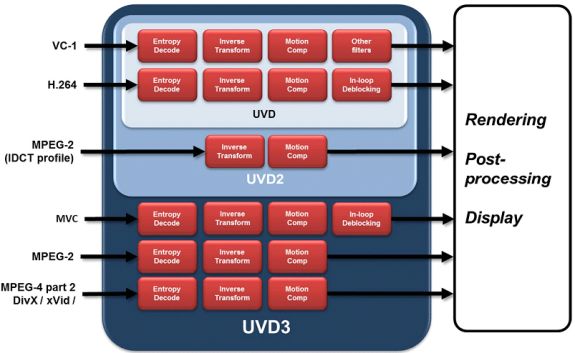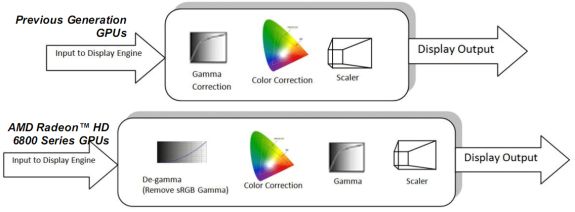AMD’s Radeon HD 6870 & 6850: Renewing Competition in the Mid-Range Market
by Ryan Smith on October 21, 2010 10:08 PM ESTSeeing the Present: HDMI 1.4a, UVD3, and Display Correction
DisplayPort wasn’t the only aspect of AMD’s display controller that got an overhaul however, AMD’s HDMI capabilities have also been brought up to modern standards. Coming from Cypress with support for HDMI 1.3, AMD now supports HDMI 1.4a on the Barts based 6800 series and presumably they will do so on the rest of the 6800 series too. With HDMI 1.4a support AMD can now support full resolution (1080p) 3D stereoscopy for movies, and 720p for games and other material that require 60Hz/eye, along with 4k x 2k resolution for monitors and TVs that have equivalent support. Unlike DP this has less to do with monitors and more to do with TVs, so the importance of this will be seen more on future AMD cards when AMD refreshes their lower-end parts that we normally use with HTPCs.
Launching alongside support for displaying full resolution 3D stereoscopic video is the hardware necessary to decode such video, in the form of the latest version of AMD’s Unified Video Decoder: UVD3. The last time UVD received a major update was with UVD2, which launched alongside the Radeon HD 4000 series and added partial MPEG-2 decoding support by moving IDCT and MoComp from shaders in to the UVD fixed function hardware.
With the Radeon 6800 series AMD is releasing UVD3, which like UVD2 before it builds on the existing UVD feature set. UVD3 is adding support for 3 more-or-less new codecs: MPEG-2, MVC, and MPEG-4 ASP (better known as DivX/XviD). Starting with MPEG-4 ASP, it’s the only new codec in supported by UVD3 that’s actually new, as previously all MPEG-4 ASP decoding was done in software when it came to AMD GPUs. With UVD3 AMD can now completely offload MPEG-4 ASP decoding to the GPU, bringing forth the usual advantages of greatly reducing the amount of work the CPU needs to do and ideally reducing power consumption in the process.
AMD adding MPEG-4 ASP support gives us an interesting chance to compare and contrast them to NVIDIA, who added similar support a year ago in the GT21x GPUs. AMD is a good bit behind NVIDIA here, but they’re making up for it by launching with much better software support for this feature than NVIDIA did; NVIDIA still does not expose their MPEG-4 ASP decoder in most situations, and overall did a poor job of advertising it. When we talked with DivX (who is AMD’s launch partner for this feature) they didn’t even know that NVIDIA had MPEG-4 ASP support. Meanwhile AMD is launching with DivX and had a beta version of the DivX codec with UVD3 support ready to test, and furthermore AMD is fully exposing their MPEG-4 ASP capabilities in their drivers as we see in this DXVA Checker screenshot.

The only downside at this time is that even with Microsoft’s greater focus on codecs for Windows 7, Windows 7 doesn’t know what to do with DXVA acceleration of MPEG-4 ASP. So while Win7 can play MPEG-4 ASP in software, you’re still going to need a 3rd party codec like the DivX codec to get hardware support for MPEG-4 ASP.
The other bit worth mentioning is that while AMD is launching support for MPEG-4 ASP decoding here on the 6800 series, much like HDMI 1.4a it’s not going to be a big deal for the 6800 series market. MPEG-4 ASP is a fairly lightweight codec, so support for it is going to be a bigger deal on low-end products, particularly AMD’s APUs if Llano and Bobcat end up using UVD3, as MPEG-4 ASP decoding in software requires a much greater share of resources on those products.
Up next is MPEG-2, which has been a codec stuck in limbo for quite some time over at AMD. MPEG-2 is even older and easier to decode than MPEG-4 ASP, and while GPUs have supported MPEG-2 decode acceleration as early as last decade, CPUs quickly became fast enough that when combined with low levels of hardware decode acceleration (inverse discrete cosine transform) was more than enough to play MPEG-2 content. Thus AMD hasn’t done much with MPEG-2 over the years other than moving IDCT/MoComp from the shaders to UVD for UVD2.
Because of the similarities between MPEG-4 ASP and MPEG-2, when AMD added support for full MPEG-4 ASP decode acceleration they were able to easily add support for full MPEG-2 decode acceleration, as they were able to reuse the MPEG-4 ASP entropy decode block for MPEG-2. As a result of including full MPEG-4 ASP decode acceleration, AMD now supports full MPEG-2 decode acceleration. Even more so than MPEG-4 ASP however, the benefits for this are going to lie with AMD’s low-end products where getting MPEG-2 off of the CPU should be a boon for battery life.

The final addition to UVD3 is support for Multiview Video Coding, which isn’t a new codec per se, but rather is an extension to H.264 for 3D stereoscopy. H.264 needed to be amended to support the packed frame formats used to store and transmit 3D stereoscopic videos, so with UVD3 AMD is adding support for MVC so that UVD can handle Blu-Ray 3D.
Finally, coupled with support for new codecs and new display outputs in AMD’s display controller is a refinement of AMD’s existing color correction capabilities in their display controller. Cypress and the rest of the 5000 series could do color correction directly on their display controllers, but they could only do so after gamma correction was applied, meaning they had to work in the non-linear gamma color space. Technically speaking this worked, but color accuracy suffered as a result. With the 6800 series’ new display controller, AMD can now perform color calibration in linear space by converting the image from gamma to linear color space for the color correction, before converting it back to gamma color space for display purposes.
As color correction is being used to correct for wide-gamut monitors the importance of this change won’t be seen right away for most users, but as wide-gamut monitors become more widespread color correction becomes increasingly important since wide-gamut monitors will misinterpret the normal sRGB colorspace that most rendering is done in.












197 Comments
View All Comments
campbbri - Friday, October 22, 2010 - link
Thanks for the great review. I don't know why everyone is complaining about mixing OC and Non-OC cards when you were extremely explicit in pointing it out.krumme - Friday, October 22, 2010 - link
I dont think you dont know why everyone is complaining.First. To be fair its far from everyone :), unfortunately because Anand is surrounded by far to many yes sayers. All positve. Great in many ways. But it does not develop the site as it could. There is a great huge community, and there is plenty of ressources to get ideas to new methology.
Its good - if not vital - that Kyle is explicit about it. Otherwise it wouldnt be worth critizicing, then it would just look like a payed job, and nobody would care. Its not. But beeing explicit is not enough even if its most important and a huge quality. You need to have a good case. And Anand does have a very bad case.
Read what Kyle wrote againg. Do you think this is his best and most sound decicion in his life? do he feel comfortable about it?
He did betray himself a little bit. And he shouldnt do it. He should lissen to his own doubt.
snarfbot - Friday, October 22, 2010 - link
yes i understand that, but i cant see how you can call a direct replacement that fails to outperform its predecessor as a success.especially when you consider that the prices have increased after launch as opposed to decrease as is normal. and have remained artificially high since, due to limitations at tsmc, which renders the cost argument pretty much moot.
how about an analogy.
6870 is to 5870 as 4770 is to 4870.
and its on the same process which makes it even worse, although you cant really blame amd for that.
you can very much blame their marketing department for making such a terrible decision though.
its a terrible name, thats the whole point, at whatever price you cant call it a 6870 if it cant beat a 5870.
Trefugl - Friday, October 22, 2010 - link
But the issue is that the 68xx series alone aren't really replacing the 58xx series. I think they are really splitting what the direct replacement to that market would have been into two - the 69xx (high-end enthusiast) and the 68xx (high-end mid-range).
I agree that the naming scheme isn't the best, but I think a lot of that could have been mitigated (and maybe even made a non-issue) if the 68xx's weren't the first to launch. If the 69xx came out first people would have accepted them and been happy, but instead we have b*tching because of naming confusion...
Targon - Sunday, October 24, 2010 - link
I missed this too until someone pointed out what I missed. The Radeon 6900 series will replace the 5800 series at the high end, and IS the proper high end part you are looking for.Back when DirectX 9 first came out, ATI only had DirectX 9 support in the old Radeon 9500 and 9700. When the X300, X600, and X800 came out, notice that AMD took the cards and started at 600 and 800, rather than 500 and 700 for the mid ranged and high end cards. This has continued a bit. In the HD 2000 series, you even had the HD 2900XT on the high end of the series, but then they went to the 3800, 4800, and 5800 series to mark the high end cards.
So, AMD/ATI has been tweaking the names a fair bit. What initially threw me off is that the next generation high end cards are not the first cards to show up, and we have the mid-ranged cards showing up first.
If the article said clearly, "We are reviewing the next generation mid range cards with the high generation 6900 due out next month" right up front in the article instead of buried in the text somewhere on page 2(or was it 3), there would have been less confusion.
I don't mind the change in numbers if all parts come out at the same time, but for now, there is ONLY confusion because we have yet to see the 6970.
GaMEChld - Friday, October 14, 2011 - link
I love how people are arguing over this naming change. As if people who buy discrete cards or look at video card specs don't know what their doing. If you don't know what you're buying, it serves you right.I don't know why this was so hard for people to understand. The 5700 was incredibly successful. AMD wanted to preserve that card for its performance and value. Thus, the 6700 name was taken. The 6800 model is a new model that sits BETWEEN where the 5700 and 5800 line had. If you recall, there was a MASSIVE performance gap between those lines, and AMD felt they should have something to bridge that gap.
The new 6800 line bridges that gap. It offers NEAR 5800 power at a significant price reduction.
And now ALL of the top tier cards are housed under the 6900 bracket, with the 6990 taking the dual GPU slot. If I had anything to complain about its the abandonment of the X2 designation on dual GPU cards.
In fact, the only thing people should be angry about is the fact that the 6700 is virtually identical to the 5700 and offers little performance advantage. THAT is what is reminiscent of the 8800GT -> 9800GT transition. However, since the 5700 was a midrange product, maybe it received less attention than it should have.
DanaG - Friday, October 22, 2010 - link
Now, if the 6870 is what should've been a 6770, and a 6970 is what should've been a 6870... then what'll they call what should've been a 6970? 6-10-70 / 6ten70? 6X70? 6999? Or will they go to 6970 X2?spigzone - Saturday, October 23, 2010 - link
6990 ... yhat wasn't so hard now, was it?AMD_Pitbull - Saturday, October 23, 2010 - link
Gotta say, I agree 100%. I really don't understand why everyone is getting so bloody upset with this. New product, new line. You couldn't predict what was going to happen? Sorry. Companies like to keep people guessing.Also, if you really want to get technical, this 6870 DOES beat the 5870 if a few things as well. Overall greater effective product AND cheaper? Win in my books. Sorry QQ'ers.
dvijaydev46 - Saturday, October 23, 2010 - link
I tried converting a video file using my 5770 Hawk with MediaEspresso 6 (with hardware acceleration enabled of course), I wasn't impressed but Mediashow 5 properly utilized the GPU power and the speed difference in converting was clear. I'm not sure if there was a problem in the installation of my copy of MediaEspresso 6, but I think you guys can use Mediashow 5 to see if there is any difference in video conversion time with an AMD GPU as I don't have any other card.